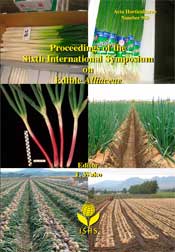Ver ítem
- xmlui.general.dspace_homeCentros Regionales y EEAsCentro Regional Mendoza - San JuanEEA La ConsultaArtículos científicosxmlui.ArtifactBrowser.ItemViewer.trail
- Inicio
- Centros Regionales y EEAs
- Centro Regional Mendoza - San Juan
- EEA La Consulta
- Artículos científicos
- Ver ítem
Variability of Allium sativum group sativum clones in Mendoza, Argentina
Resumen
Garlic came to Argentina mainly with the European immigration during the past century. Among the group sativum populations entered the most important were those brought by Italian and Spanish. Although accepted to belong to a same group those populations are clearly distinguishable in at least two major subgroups: the white type (“soft-neck”, creamy colored cloves) and the red type (“hard-neck”, cloves pinkish-striated to red). Both types are markedly
[ver mas...]
Garlic came to Argentina mainly with the European immigration during the past century. Among the group sativum populations entered the most important were those brought by Italian and Spanish. Although accepted to belong to a same group those populations are clearly distinguishable in at least two major subgroups: the white type (“soft-neck”, creamy colored cloves) and the red type (“hard-neck”, cloves pinkish-striated to red). Both types are markedly different in many morphological and physiological traits; despite in other physiological subjects they are quite similar. Since 1989, the Garlic Project of INTA (The National Institute of Agricultural Technology, Argentina) has obtained and registered sixteen clonal cultivars so far, most of them of the group sativum, only exploiting the natural variability present in their original populations. Yield potential is the main characteristic searched to differentiate cultivars, although they also show important differences in earliness and some functional traits (i.e., organosulfur and fructans contents). In a 3-year survey of ten high yielding clonal cultivars at La Consulta (Mendoza, Argentina; 33.70 S, 69.7 W, 950 meters above sea level), yield per plant (mean bulb weight) ranged from 73.37 g to 105.64 g among white-type clones and from 57.48 g to 95.30 g among red-type clones. Differences were statistically significant among most of the cultivars, whereas the main effect of clones accounted for 54% and 41% of the squared sum of the model in the white and red type respectively. Furthermore, a yield index which integrates bulb weight, plants survival at harvest and main attributes of bulb quality, showed a high clone-year interaction in the white type (48% of the squared sum), while in the red type the clone-year interaction was slightly important (18% of the squared sum). It is remarkable the vast natural variability existent in Mendoza, Argentina, within the group sativum.
[Cerrar]

Descripción
Presentado al VI International Symposium on Edible Alliaceae
Fuente
Acta Horticulturae 969 : 97-102. (2012)
Fecha
2012-12
Editorial
International Society for Horticultural Science
ISSN
0567-7572
ISBN
978-90-66056-95-4
Formato
pdf
Tipo de documento
artículo
Palabras Claves
Derechos de acceso
Restringido
 Excepto donde se diga explicitamente, este item se publica bajo la siguiente descripción: Creative Commons Attribution-NonCommercial-ShareAlike 2.5 Unported (CC BY-NC-SA 2.5)
Excepto donde se diga explicitamente, este item se publica bajo la siguiente descripción: Creative Commons Attribution-NonCommercial-ShareAlike 2.5 Unported (CC BY-NC-SA 2.5)

